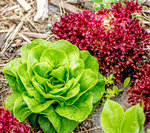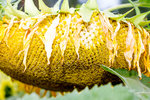Now is the time for teachers to return to their schoolhouses for a week of training and meetings and planning and preparing their rooms for the return of pupils.
But at Salish Coast Elementary one classroom is already decorated to the max: the 5,000-square-foot teaching garden where Emily Hiatt will help students and teachers learn about soil biology, seed development, vegetable production and the joys of outdoor work.
On Thursday, Aug. 29, when parents and pupils show up for back-to-school night, they’ll see brilliant squash blossoms, sunflowers and scarlet beans blooming behind the high deer fence.
Principal Lisa Condran said the school committee of teachers and students plans to greatly expand it, adding another 10,000 square feet of production garden to stock the cafeteria larder, but even now, the blooming spot is central to their plans for project-based science.
Salish Coast has committed itself to outdoor lessons, but also to serve scratch-made meals using locally-sourced food. The kitchen is known to buy a side of beef, freeze it and use every part from head to tail. And when the production garden is up and running, produce will be wheeled into the school kitchen, too.
During construction on the school, soil from the old garden at Grant Street was saved and moved to the new location. Even that heavy lifting allowed for useful lessons, as they observed the life in well-tilled, well-fed soil, which supports worms and other creatures that move nutrients through the dirt, making them available to plant life.
Hiatt said this week she is adding a raised bed to make garden experiences accessible for students in wheelchairs.
All that science and biology is important, but there’s some whimsy, too. Hiatt planted a little tipi of scarlet beans that attracts bees and hummingbirds.
“Having them surrounded by plants is really important,” she said. “The kids can sit in there and peek out” at the pollinators who fly in for a visit.
She said one bed of carrots is being allowed to go to seed to give students the opportunity to close the full life cycle of a plant from seed to sprout to fruit and then to seed once more.


